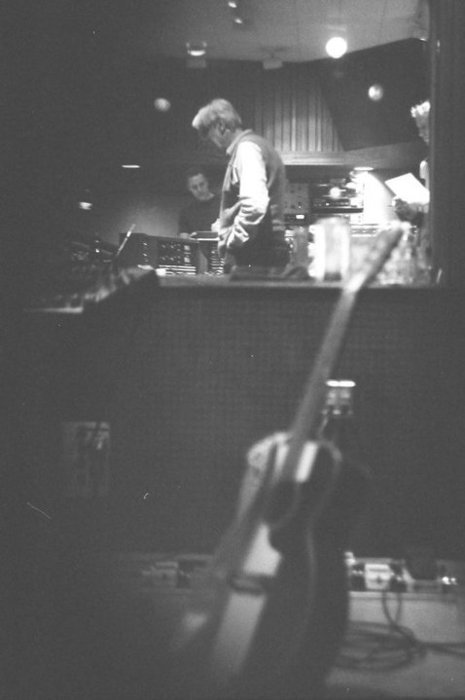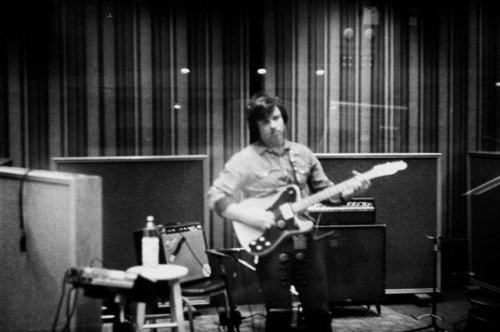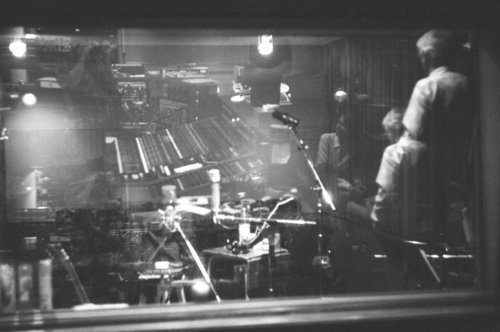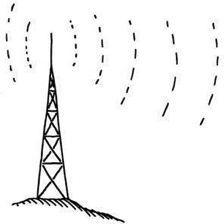 Setting aside discussion of the great songs themselves, Ryan Adams’ Ethan Johns-produced albums have been a well of inspiration over the years just in terms of being beautiful studio recordings. It was a thrill, then, to hear that Adams is working with Glyn Johns — Ethan’s father and mentor in addition to being one of the greatest rock producers of all time (partial discography) — for his first collection of new original material since 2008’s Cardinology. Anticipation ran high upon that news, sure, but a collection of pictures dubbed “Purposefully Mysterious & Obscure Photos of the Studio” by Adams on Facebook yesterday only made that anticipation more palpable. Feel free to join me for a look at a few shots with captions and visual hints for what’s to come on Adams’ next LP below:
Setting aside discussion of the great songs themselves, Ryan Adams’ Ethan Johns-produced albums have been a well of inspiration over the years just in terms of being beautiful studio recordings. It was a thrill, then, to hear that Adams is working with Glyn Johns — Ethan’s father and mentor in addition to being one of the greatest rock producers of all time (partial discography) — for his first collection of new original material since 2008’s Cardinology. Anticipation ran high upon that news, sure, but a collection of pictures dubbed “Purposefully Mysterious & Obscure Photos of the Studio” by Adams on Facebook yesterday only made that anticipation more palpable. Feel free to join me for a look at a few shots with captions and visual hints for what’s to come on Adams’ next LP below:

“I crossed out the names of tunes as we went. This was like day ten. The whole thing was 14 days. Seriously.”
Looks like over a dozen tunes were recorded during the relatively short, 2-week sessions, which were the exact span of time Adams spent recording his debut solo LP, Heartbreaker.

“I got my Buck Owens acoustic (the one I used on Cold Roses and JCN fixed. I had the neck re-set and I used it on every song ( except two where I used the Guild with the Indy Speedway sticker- the one I had since before Heartbreaker– sadly Guild is old and stay in tune for only a song or two.)”
Great news for fans of Adams’ solo-acoustic material. You can preview his sound while playing the Guild by checking out a classic, Heartbreaker-era solo performance in which he uses said 6-string here.

“That’s where the computer stuff goes when you do it right. Not one computer or pro tools or digital thing went into this record. I don’t think I will ever do it any other way again given the chance.”
As a longtime proponent of analog recording, this comment pleases me to no end. After a number of years dabbling in digital, it appears that Adams’ opinion on the matter has reverted back to what he said in a 2001 interview with Toazted:
“I’m not a fan [of digital]. Analog recording for me I think is a truer format for recording. Because digital recording, I think, is scientifically… you actually lose hertz. You lose 30 to 20 percent of top and bottom of recording. When you listen to music, your body listens as well as your ears. So digital recording is very good for your ears, but not very good for absorbing bass and hearing higher end treble. So, for me personally, I don’t care to ever record in that fashion and don’t. Not because I’m a purist, but honestly because I feel that analog records sound better.”

“In the reflection the big circular faders for the lights in the control room made it look like I have flying saucer balls….”
LOL. No comment, except to point out another wonderful past Adams performance here. This time he’s rocking the same (or similar) Fender Telecaster shown above in 2001.

“Sunset Room B- this board is incredible. Sunset Sound Mic-Pres are like nothing else I have heard. And some parts of the console are API but really it is it’s own special frankenstein. We monitored through the Mains which the guy who designed the rooms at Sunset voiced right before. unreal!”
Adams has recorded at Sunset Sound many times before, but it’s worth noting, given his famous producer on this project, that dozens of timeless LPs were put to tape in this Los Angeles building by the likes of Neil Young, the Stones, the Doors, and many more. For an excellent history of this national rock treasure with photos, go here.
Also (for studio geeks), note the Shure SM7 vocal microphone, which was used heavily on 29 and many other Ethan Johns-produced recordings.

“Mixes”
Simply an exciting shot of Johns and Adams presumably mixing the finished product. Is the record done? Perhaps, and I can’t wait to hear it.
